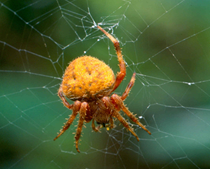Magical Garden Orbs
Fall is the
time of year when we see many spiders at the park. Last week in the garden I
came across this lovely spider enjoying her breakfast. I decided to get to know this spider a little
better.
Marbled
Orb Weaver Crab Spider
Jumping
Spider Arrowhead Spider
My spider is one of more than 45,000 spider species in the world. They can be
found everywhere but the poles, oceans, and high mountains.
Wolf Spider with eye
shine
Photo credit Sullivan County Conservation District
Spiders are
found both day and night. They are easy to find at night because their eyes
shine when exposed to light light. A fun activity is to
look for spider eye shine after dark. Take your flashlight out and look for
glowing green dots along the side of the trail, in bushes or on your darkened
porch. Those are spider eyes.

Wolf Spider with Egg
Sac
Only about
fifty percent of the spider species spin webs.
Other spiders, such as this wolf spider, live in the ground, on plants,
or under low growing bushes. These
spiders are excellent hunters.
Orb Web
The spider in the
garden is a yellow garden spider. Argiope
aurantia. It is one of 4000 species of orb weavers.
Yellow Garden Spider
This species of spider, like all spiders, has eight legs, a cephalothorax, abdomen, fangs, and a silk spinner. Unlike other spiders, this species has a unique third claw on each leg to help spin complex webs. Spiders have from zero to eight eyes. My garden spider has eight.
Marbled Orb Weaver
Spinning a Web
Photo Credit Kim
Bailey
A typical orb web spider builds a web
between two very strong supports. Two
types of silk are used. The first, a
non-sticky silk, creates the radial threads of the web. The frame of the web is made by the same
silk The other spiral threads are made
of a sticky silk, which is clingy. Most
orb spiders eat and rebuild at least part of their web every day or night. On average it takes 30 to 60 minutes for this spider to
spin its web. A yellow garden spider
uses her web for a few days.
Yellow Garden
Spiders on her Web
The web is almost like an extension of their bodies, used to
catch meals and increase their awareness of the world around them. Orb spiders have very poor
eyesight, but they don’t need to see well because of the way they use their webs. There are special lines in their webs to sense prey. When something
touches these lines, the lines vibrate, and the vibrations are a message to the
spider, telling it there is something in the web. The spider can tell by the
way the web vibrates if the movements a struggling insect victim, or something
else.
Writing Spider
Notice the zigzag in the
middle of the web. The “zipper” or “zigzag” in question is called the
‘stabilimentum”. Scientists are not
sure why the spiders spin these structures.
One theory is it provides stability to the web. Another theory is it attracts insects by
reflecting UV light. A third is it warns
birds not to fly through the web, thereby preserving the web. Scientist are
studying the webs to find the answer. The zigzag has also earned this spider
the nickname Writing Spider.
Yellow Garden Spider
Catching Prey Yellow Garden Spider Eating Prey
Yellow Garden Spider Wrapping Prey
As stated the web is used to catch prey. The orb spider prepares its trap by putting
sticky drops on a thread in the web, and then “plucking” the thread (like a
string of a guitar) with a leg. This spreads the sticky drops along the silk
lines of the web. When it catches an insect, an orb spider uses its front legs
to quickly spin the insect as it uses its back legs to pull out silk, wrapping
the victim like a mummy. Because the
spider liquifies the prey with enzymes, the spider can wait several hours to
days before eating it.
Yellow Garden Spider Wrapping Prey
As stated the web is used to catch prey. The orb spider prepares its trap by putting sticky drops on a thread in the web, and then “plucking” the thread (like a string of a guitar) with a leg. This spreads the sticky drops along the silk lines of the web. When it catches an insect, an orb spider uses its front legs to quickly spin the insect as it uses its back legs to pull out silk, wrapping the victim like a mummy. Because the spider liquifies the prey with enzymes, the spider can wait several hours to days before eating it.
Check out this video of a yellow garden spider and her mate.
Want to know a little more?
Check out our TikTok.
Orb web with spider at night
These
amazing creatures are all around us.
Take some time to explore spiders and discover what amazing creatures
they are.



















No comments:
Post a Comment